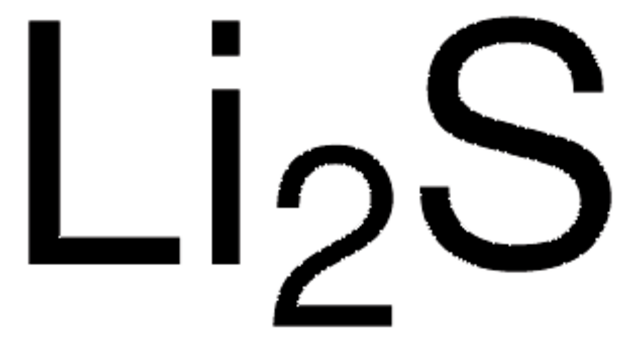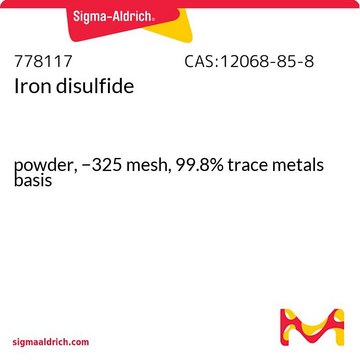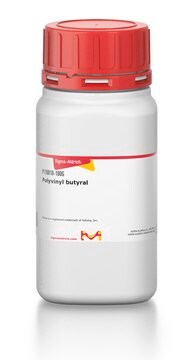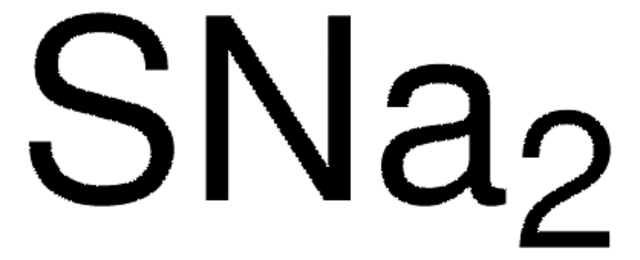342459
Copper(I) sulfide
powder, −325 mesh
Synonyme(s) :
Cuprous sulfide
Se connecterpour consulter vos tarifs contractuels et ceux de votre entreprise/organisme
About This Item
Formule empirique (notation de Hill):
Cu2S
Numéro CAS:
Poids moléculaire :
159.16
Numéro CE :
Numéro MDL:
Code UNSPSC :
12352302
ID de substance PubChem :
Nomenclature NACRES :
NA.23
Produits recommandés
Forme
powder
Niveau de qualité
Taille des particules
−325 mesh
Densité
5.6 g/mL at 25 °C (lit.)
Application(s)
battery manufacturing
Chaîne SMILES
[Cu]S[Cu]
InChI
1S/2Cu.S
Clé InChI
JESPAFKOCOFQIN-UHFFFAOYSA-N
Vous recherchez des produits similaires ? Visite Guide de comparaison des produits
Description générale
Copper sulfide shows metal-like electrical conductivity, chemical-sensing capability and suitable characteristics for absorption of solar energy. Cu63 NMR, X ray photoelectron spectroscopy,2 copper sulfide CuS was studied in detail. Copper sulfide is a monovalent and oxidation state was determined to be 2.2
Application
- Pharmacological Study on Ocfentanil: Research on the pharmacological properties of Ocfentanil, including its biochemistry and potent analgesic effects, was explored in a study where toxicology and behavioral impacts on zebrafish larvae and mice were assessed, confirming its potential for pain management applications (Bilel et al., 2023).
- Ocfentanil in Surgical Procedures: Ocfentanil′s role in surgical applications was highlighted in a study where new analytical methods were developed for its detection in biological samples, emphasizing its significance in pharmacological studies and surgical pain management (Jung et al., 2020).
- Ocfentanil Solution for Pharmacological Studies: The development and validation of a method for detecting Ocfentanil in hair samples indicate its critical role in forensic and pharmacological research, aiding in studies focused on its stability and effects within clinical settings (Allibe et al., 2021).
Conditionnement
Packaged in poly bottles
Autres remarques
may contain a slight excess of S
Code de la classe de stockage
11 - Combustible Solids
Classe de danger pour l'eau (WGK)
WGK 3
Point d'éclair (°F)
Not applicable
Point d'éclair (°C)
Not applicable
Équipement de protection individuelle
Eyeshields, Gloves, type N95 (US)
Faites votre choix parmi les versions les plus récentes :
Déjà en possession de ce produit ?
Retrouvez la documentation relative aux produits que vous avez récemment achetés dans la Bibliothèque de documents.
Les clients ont également consulté
Synthesis of copper sulfide nanorod arrays on molecular templates.
Mao G, et al.
Nano Letters, 4(2), 249-252 (2004)
Lidia Armelao et al.
Journal of nanoscience and nanotechnology, 6(2), 401-408 (2006-04-01)
A novel method for the preparation of CuS nanoparticles based on the fast nucleation of the sulphide has been developed. The particles have been synthesized by reaction of thioacetic acid with water and copper carboxylates (acetate, propionate) in the corresponding
Riccardo Narizzano et al.
The journal of physical chemistry. B, 109(33), 15798-15802 (2006-07-21)
A heterostructure formed by a conjugated polymer and semiconducting nanoparticles was produced. The conjugated polymer was synthesized by oxidative copolymerization of 3-thiopheneacetic acid and 3-hexylthiophene, thus obtaining an amphiphilic polythiophene that allows the formation of a stable polymer layer at
Yuming Guo et al.
Chemical communications (Cambridge, England), 46(20), 3493-3495 (2010-04-09)
Copper sulfide amorphous nanoparticles and nanocrystals were prepared successfully by a special process. These CuS nanoparticles could specifically and significantly induce the apoptosis and inhibit the proliferation of human cancer cells rather than normal cells. Moreover, the biological activities of
Xiangjie Bo et al.
Talanta, 81(1-2), 339-345 (2010-03-02)
A simple and facile synthetic method to incorporate copper sulfide (Cu(2)S) nanoparticles inside the mesopores of ordered mesoporous carbons (OMCs) is reported. The Cu(2)S/OMCs nanocomposite was characterized by transmission electron microscopy (TEM), X-ray diffraction (XRD), X-ray photoelectron spectroscopy (XPS), and
Notre équipe de scientifiques dispose d'une expérience dans tous les secteurs de la recherche, notamment en sciences de la vie, science des matériaux, synthèse chimique, chromatographie, analyse et dans de nombreux autres domaines..
Contacter notre Service technique












